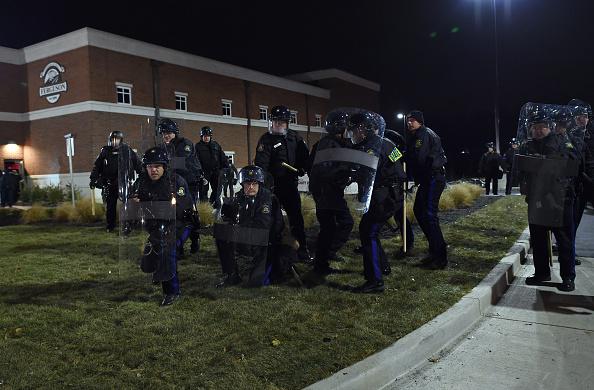Ferguson police officer Darren Wilson will not be indicted for the fatal shooting of unarmed teenager Michael Brown, St. Louis County prosecutor Bob McCulloch said in a statement on Monday night. After months of deliberation, on Monday a grand jury returned its decision that Wilson will not face charges, as the St. Louis suburb braced for potential unrest as a result of the decision.
“We are profoundly disappointed that the killer of our child will not face the consequence of his actions,” the Brown family said in a statement after the announcement. “While we understand that many others share our pain, we ask that you channel your frustration in ways that will make a positive change… We respectfully ask that you please keep your protests peaceful.”
The grand jury—made up of nine white and three black jurors—first took up the case on Aug. 20, in order to decide if there was probable cause Wilson committed a crime on Aug. 9 when he shot Michael Brown while on duty. Over the last three months, all twelve jurors were present at each of the 25 grand jury meetings, which amounted to more than 70 hours of testimony, according to St. Louis County prosecutor McCulloch. “Officer Wilson took the unusual step of testifying before the grand jury, appearing for more than four hours on an afternoon in September to defend his actions, and he said he was convinced that his life was in danger,” according to the New York Times. Here’s more on what the jurors had to consider from the Times:
At 12:01 p.m., Officer Wilson appeared on the scene, driving alone in his police vehicle. Through the driver’s side window of his Chevrolet Tahoe, he issued an order: Leave the street and walk on the sidewalk. At this point, accounts differ widely. Mr. Johnson has said that Officer Wilson reached through the open window and grabbed Mr. Brown by the neck, choking and pulling him. According to an account that Officer Wilson gave to various authorities, Mr. Brown was the aggressor, punching him in the face and scratching him on the neck. Pinned in his vehicle, Officer Wilson, according to his statements to the authorities, feared for his life and, with his right hand, drew his gun from the holster. As the two continued to struggle, Officer Wilson fired the gun twice, forensic evidence revealed. One shot hit Mr. Brown in the hand, a county autopsy found… Officer Wilson left the car, pursued Mr. Brown on foot and continued to fire. Two construction workers who were on Canfield Drive at the time said in interviews with the news media that they had seen Mr. Brown with his hands up when he was shot. One of the workers said “the officer was chasing him.” Other witnesses said Mr. Brown had turned around and was moving toward Officer Wilson.
The shooting became a flash point triggering weeks of protests in Ferguson that occasionally turned violent. The Brown shooting, as well as the police’s military-like response to protests, reignited a national debate on race and the police. In the lead up to the grand jury’s decision, local and and national leaders appealed for calm. President Obama weighed in over the weekend saying in an interview: “Using any event as an excuse for violence is contrary to the rule of law and contrary to who we are.” Ahead of the announcement, the New York Times reported, “[a]round this St. Louis suburb, law enforcement authorities were on alert and the Missouri National Guard stood by; political leaders, including Gov. Jay Nixon, were holding last-minute meetings with community members; and residents, including parents of schoolchildren, were bracing for what might come next.”
*This post has been updated.
